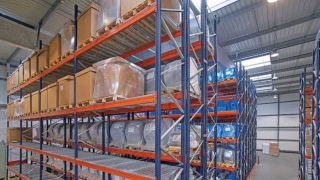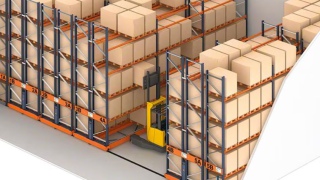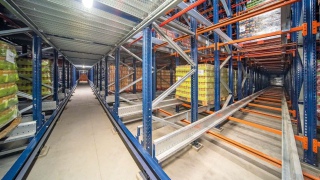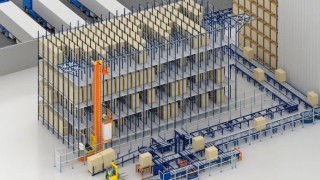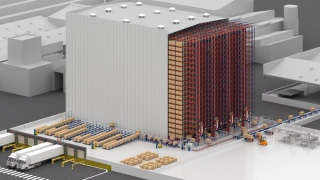Maximizing Space Efficiency with Warehouse Racks
Maximizing Space Efficiency with Warehouse Racks
Warehouse racks are vital for efficient storage solutions. They help maximize space and improve organization in storage facilities.
Choosing the right type of rack is crucial. It depends on the specific needs of your warehouse. Options include pallet racks, cantilever racks, and metal shelving.
Each type offers unique benefits. Pallet racks are great for large, palletized goods. Cantilever racks handle long, bulky items like lumber. Metal shelving is versatile for smaller items.
Properly organized racks enhance inventory management. They reduce retrieval times and improve workflow. Safety and maintenance are also key considerations.
This guide will explore how to select and use warehouse racks effectively. Learn how to optimize your storage space and boost efficiency.
The Importance of Warehouse Racks in Modern Storage
Warehouse racks play a pivotal role in today's storage environments. They enable efficient use of space, which is crucial as storage needs grow. With increasing demands, maximizing available space becomes essential.
Warehouse racks contribute to better organization and accessibility. They help staff find items quickly, which boosts productivity. Efficient organization also reduces the risk of damage to goods.
Different types of racks cater to various storage requirements. This adaptability makes them indispensable across industries. Racks provide solutions for both lightweight and heavyweight items.
Here are some key benefits of using warehouse racks:
- Optimize vertical space utilization
- Improve inventory management
- Enhance safety and accessibility
Warehouse racks support heavy loads, making them suitable for industrial applications. By organizing products systematically, they facilitate smoother workflows. This efficiency directly impacts a company's bottom line.

In summary, warehouse racks are more than just storage aids. They are integral to achieving a streamlined, efficient storage operation. Their importance in modern storage cannot be overstated.
Types of Warehouse Racks: Finding the Right Fit
Selecting the right type of warehouse rack is key to maximizing storage efficiency. It depends on various factors, including the type of goods stored and the layout of the facility. Each rack type offers distinct benefits suitable for different needs.
Pallet racks are ideal for businesses dealing with large quantities of palletized goods. They allow for easy stacking and retrieval, making them a staple in warehouses. Their robust design supports significant weight, accommodating heavy loads.
Cantilever racks offer solutions for long, bulky items such as lumber or pipes. These racks provide open access, enabling easy loading and unloading. They are perfect for items that do not fit in traditional rack systems.
Here are some characteristics to consider when choosing warehouse racks:
- Weight capacity
- Accessibility
- Adaptability
Metal shelving provides versatility and is suitable for smaller items or boxes. It is often used in areas requiring frequent access to individual items. Metal shelving is durable and can be tailored to fit specific dimensions.
Industrial racks come in various configurations. They can be customized to meet unique storage needs. Their strength makes them suitable for diverse industrial applications, adapting to different product sizes and weights.
Before choosing, consider your specific storage needs:
- Types of items stored
- Frequency of access
- Available space
Selecting the right warehouse rack is crucial for efficient space utilization. By understanding the options available, businesses can tailor their storage solutions effectively.

Pallet Racks: The Backbone of Warehouse Storage
Pallet racks are a crucial element in warehouse storage systems. Designed to store palletized goods, they make handling large inventories more manageable. Their design ensures easy use with forklifts for quick loading and unloading.
These racks come in various styles, such as selective, drive-in, and push-back. Each style offers unique advantages, addressing different warehouse needs. Selective racks provide direct access to each pallet, while drive-in systems save significant space.
Benefits of using pallet racks include:
- High-density storage
- Easy access to goods
- Efficient use of space
Pallet racks are the backbone of many storage facilities. They offer stability and support for heavy pallets, ensuring safety and efficiency. By optimizing space and ease of access, they improve overall productivity.

Cantilever Racks: Solutions for Long and Bulky Items
Cantilever racks are essential for storing lengthy, cumbersome items. Traditional racks often fall short for products like lumber or piping. Cantilever racks feature arms that extend out, holding the items securely.
These racks allow free access from the front, making it easy to load and unload. Their design accommodates varying product lengths. This flexibility is particularly useful in industries dealing with irregularly sized materials.
Key features of cantilever racks:
- Adjustable arms for flexibility
- Open design for easy access
- Sturdy construction for heavy loads
For businesses requiring storage for long products, cantilever racks are indispensable. They ensure efficient use of space and enhance inventory management.
Metal Shelving and Industrial Racks: Versatility and Strength
Metal shelving is versatile, addressing various storage needs. It suits environments requiring frequent access to stored goods. Metal racks are customizable, adapting to different height and width requirements.
This type of shelving is robust, supporting varied items. It's commonly found in warehouses needing to organize smaller, loose goods effectively. Metal racks stand out for their adaptability and strength.
Considerations for metal shelving:
- Durability
- Customizability
- Weight-bearing capacity
Industrial racks are essential for managing diverse items. They offer a range of configurations to suit different types of storage needs. Their strong construction supports various industrial applications effectively.
Choosing the right shelving involves assessing both current and future storage requirements. By selecting versatile and strong solutions, businesses can significantly improve their storage efficiency.

Key Factors in Selecting Warehouse Racks
Choosing the right warehouse racks involves evaluating several crucial factors. These considerations ensure that the storage solution aligns with business needs. The right selection promotes efficiency and safety.
First, consider the types of goods you plan to store. Different products might need different rack systems. For example, lighter items fit well in metal shelving, while heavy pallets need sturdy pallet racks.
When selecting racks, take into account the available space in your warehouse. Maximizing vertical space can significantly increase storage capacity. Racks should fit seamlessly into your facility's layout.
Essential factors to consider:
- Space availability
- Types of stored items
- Floor layout
It is important to assess the load capacity of the racks. Ensure they can withstand the weight of your inventory. Installing a rack with the appropriate load rating prevents accidents and prolongs its lifespan.
Additional factors:
- Load requirements
- Ease of access
- Future expansion plans
Lastly, factor in the flexibility of the storage system. Adjustability can help accommodate fluctuating inventory needs. Movable components or adjustable shelves can adapt to changing product dimensions.
Maximizing Space: Layout and Design Strategies
Efficient warehouse layout and design play a critical role in space optimization. A well-organized floor plan ensures the best use of available square footage. Creative strategies can dramatically enhance storage capacity.
Begin by assessing the current warehouse structure. Identify bottlenecks and underutilized areas. Maximizing vertical space is often an overlooked solution. By using tall racks, a warehouse can store more items within the same footprint.
Consider these layout tips:
- Position racks to streamline workflow.
- Allow adequate aisle width for equipment.
- Use vertical space effectively.
Design should facilitate easy access to goods. Maintaining clear, accessible pathways improves both speed and safety. Flexibility in your design allows for future growth and changes in inventory.
Effective design elements:
- Clear signage for easy identification
- Adjustable racks for dynamic inventory
- Modular systems for reconfiguration
Analyze your facility's specific needs to tailor your strategy. Customized layouts enhance operational efficiency. Implementing these design principles can significantly improve space use.
Safety and Maintenance Best Practices
Safety is paramount when it comes to warehouse racks. Proper installation and usage prevent accidents. Regular maintenance keeps racks in optimal condition.
Begin with thorough training for all warehouse staff. Everyone should understand safe loading and unloading techniques. Routine inspections help identify potential hazards before they become issues.
Key maintenance practices include:
- Regularly check for damage or rust
- Ensure secure bolting and fastening
- Adjust loads to prevent overloading
Prioritize clear communication on safety protocols. Use signage to remind employees of weight limits and safety rules. Implementing a scheduled maintenance plan extends the lifespan of warehouse racks and enhances overall safety.
Integrating Technology and Automation with Warehouse Racks
Integrating technology with warehouse racks transforms operational efficiency. Advanced systems simplify inventory management and tracking, which significantly enhances productivity. Automating routine tasks frees up staff to focus on more complex duties.
Consider pairing racks with smart technologies such as RFID and barcode systems. These tools offer real-time inventory updates and precise tracking. Moreover, automated handling equipment, like robotic forklifts, can operate seamlessly with warehouse racks.
Advantages of technology integration include:
- Improved inventory accuracy
- Faster order processing
- Enhanced labor efficiency
Businesses benefit from these innovations by reducing errors and increasing speed. Embracing technology aligns storage practices with modern demands.
Cost Considerations and Long-Term ROI
Investing in warehouse racks requires careful evaluation of costs versus benefits. The initial expense may seem high, but long-term savings often outweigh it. Efficient space usage leads to reduced need for additional storage facilities, which cuts costs.
Evaluate potential ROI by considering several factors:
- Increased storage capacity
- Reduced retrieval times
- Enhanced inventory management
High-quality racks offer durability and extended lifespan, maximizing return on investment. By optimizing operational efficiency and leveraging the full potential of storage space, businesses see substantial financial advantages over time. Prioritizing well-planned investments supports sustainable growth.

Sustainable and Scalable Storage Solutions
Warehouse racks contribute significantly to sustainable storage practices. By maximizing existing space, they reduce the necessity for building new structures. This efficient use of space minimizes the environmental footprint.
Considerations for scalable solutions include:
- Adapting to future growth
- Supporting various storage needs
- Enhancing space utilization
Racks that can expand or adjust ensure future compatibility with changing inventory demands. Flexibility in design enables businesses to manage increased goods efficiently. Thus, racks not only support current needs but also future-proof storage systems.
Conclusion: Achieving Operational Excellence with Warehouse Racks
Warehouse racks play a pivotal role in storage efficiency. They are fundamental to optimizing space and improving operations. With the right selection and maintenance, these racks can transform a facility’s performance.
Investing in diverse rack systems supports operational excellence. From enhancing workflow to enabling growth, the benefits are substantial. Effectively managed racks lead to sustained success and competitive advantage.
_0x70_d59.png)
